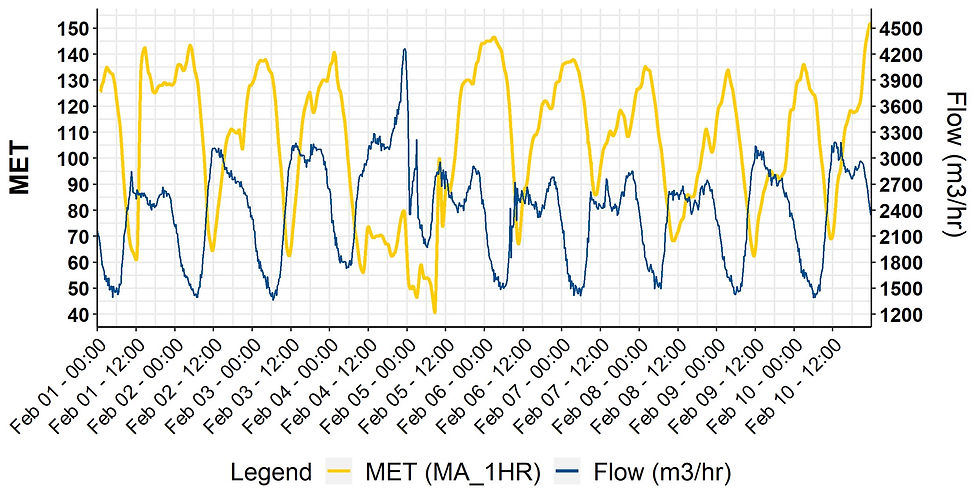Microbes know – It's not just flow!
- Jon Grant

- May 24, 2019
- 3 min read
Changing hydraulic conditions in a wastewater treatment plant presents a real process challenge for wastewater operators. The lack of comprehensive high-resolution water quality data has necessitated the assumption that water quality changes simultaneously and predictably with flow.
This assumption fails in many cases and its use in control results in sub-optimal process management. Improvements in process control utilizing water quality information will lead to operational cost savings. The equipment or procedures required to collect the traditional suite of parameters are typicaly expensive and time-consuming to maintain.
Recent installations of SENTRY bio-electrode monitoring systems with municipal partners have allowed us to show that changing flow is not the only metric for operations to consider when looking to optimize plant performance. Changing flow can also come with chaging organic concentration of the wastewater and the bio-availability of food for microbial populations. The data presented here shows a typical off-set of daily flow and microbial electron transfer (MET) from the biology in the primary clarifier of a WWTP. This information is helpful for opertors to better understand the impact changing flow is having on the incoming wastewater stream and from this can better predict / understand how this will impact his downstream biological activity.

Biological water quality data collected by SENTRY reveals that changes in flow to a facility does not correlate directly to organic load. Municipal plant influent flow and MET (microbial activity) are typically characterized with diurnal trends that are stable and predictable (Figure 1). However, water quality and flow do not vary simultaneously as can be seen in the offset of the peaks and troughs by 4 hours (in this case). As a result, controlling solely by flow is likely to result in the control response ramp up and down to respond to organic load to occur too early/late and will result in unnecessary energy usage or chemical addition(s). A control loop conditioned only by the flow data is acting blindfolded regarding the biological water quality of the process and is missing optimization opportunities.
What can we learn from this information?
(1) The bio-availability and rate or carbon metabolism at the WWTP is highest toward the end of day, after the high flow period of the day.
(2) The bio-availability / rate of carbon metbolism at the WWTP is lowest when the initial daily slug comes to the facility in the morning.
This information (for domestic wastewater streams) could be indicitive of the treatability of wastewater in the system and the bio-availabilty of the carbon that comes to the facility.
To examine this further we can look at how microbial activity is impacted under high-flow conditions caused by heavy rain events!
The relationship of flow and water quality also can have periods of divergence and operating on only flow can result in intermittent (but significant) periods when the plant is running inefficiently. This was demonstrated in a large snow melt event depicted in Figure 2. Despite flow being greatly elevated, the MET dropped substantially and remained depressed. This is contrary to the general relationship where higher flows drive microbial activity higher. The deviation from the typical relationship can be traced to atypically water quality as determined by the low organic strength in the influent as a BOD5 measurement on February 5th was 61 mg/l compared to the average from January-March of 109 +/- 5 mg/l. Operation based on flow would have unnecessarily brought treatment trains online and/or increased aeration at a perceived massive increase in organic loading.

This is another example of where higher flow does not correlate to increasing organic load being received by the wastewater treatment facility.
It is key for any process optimization to understand the bio-availablity of the incoming wastewater streams and the abilty of the resident microbial populations to consume the organics present.
SENTRY is an asset in the toolbox of any wastewater professional challenged with variable influent water quality and can be used to:
1. Optimize processes by controlling for patterns in influent water quality variability.
2. Identify abnormal conditions that require action and aid in determination of action and cause.
3. Determine cost-effective traditional sampling routine to fully characterize water quality variability.
Variable hydraulic conditions present a visible and significant operational challenge but this variability in flow bring with it changes in water quality. Water quality variability related to flow has typically gone uncharacterized because of prohibitive monitoring costs, but insight into water quality is necessary for process optimization. SENTRY is an affordable tool that fills this data gap by holistically monitoring microbial metabolism; because SENTRY microbes know - It's not just flow!!




Comments